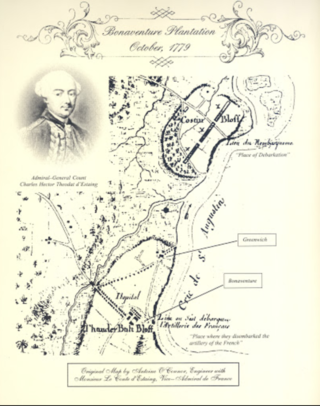
George Washington Parke Custis was an American antiquarian, author, playwright, and plantation owner. He was a veteran of the War of 1812. His father, John Parke Custis served in the American Revolution with then-General George Washington. John Parke Custis died after the Battle of Yorktown that ended the American Revolution.
El Destino Plantation was a large forced-labor farm of 7,638 acres (30.91 km2) located in western Jefferson County and eastern Leon County, Florida, United States established by John Nuttall in 1828. It was worked by enslaved African Americans.
William Temple Thomson Mason was a Virginia farmer and businessman.
Charles Blaney Cluskey was an Irish architect active from the 1830s to the start of the Civil War, and therefore he is recognized as an antebellum architect. He is reputed to be the initiator of the Greek Revival–style in the south, and his commissions, both public and private, can still be seen in Augusta, Milledgeville and Savannah, Georgia.

Bonaventure Plantation was a plantation founded in colonial Savannah, Province of Georgia, on land now occupied by Greenwich and Bonaventure cemeteries. The site was 600 acres (2.4 km2), including a plantation house and private cemetery, located on the Wilmington River, about 3.5 miles east of the Savannah colony.

Greenwich Plantation was a plantation founded in colonial Savannah, Province of Georgia, in 1765, on land now occupied by Greenwich Cemetery. The 100-acre (0.40 km2) site included a plantation house and private cemetery, and was located on the Wilmington River, about 3.5 miles east of the Savannah colony. It was located immediately to the north of Bonaventure Plantation, which existed until 1868 on land now occupied by Bonaventure Cemetery. Its mile-long driveway still exists to the left of Bonaventure's main gates.

Hugh Moss Comer was an American businessman. He was a president of the Central of Georgia Railway and co-founder of Bibb Manufacturing Company, in addition to having several directorships and self-owned companies.

Orleans Square is one of the 22 squares of Savannah, Georgia, United States. It is located in the middle row of the city's five rows of squares, on Barnard Street and West McDonough Street, and was laid out in 1815, shortly after the event it commemorates: General Andrew Jackson's victory at the Battle of New Orleans that January. It is south of Telfair Square, west of Chippewa Square and north of Pulaski Square. The oldest building on the square is the John Ash House, at 114–116 West Hull Street, which dates to 1817.
Mary Lane Morrison was an American writer, historian and preservationist. She was the curator of the Georgia Historical Society, a member of the National Society of the Colonial Dames of America in the state of Georgia and was a director in The Victorian Society, founded in 1966. She also wrote John S. Norris: Architect in Savannah, on the architectural work of John S. Norris, and edited Historic Savannah: A Survey of Significant Buildings in the Historic and Victorian Districts of Savannah, Georgia.

The Jesse Mount House, also known as the Champion–McAlpin House, is a home in Savannah, Georgia, United States. It is located at 122–124 West Jones Street and was constructed in 1852.

John Scudder was an American master builder who was prominent in the second half of the 19th century. During his time in Savannah, Georgia, he became one of the city's "most prolific and successful antebellum builders".

William Morrill Wadley was a railroad engineer, and the superintendent of several railroad projects in the Southern United States in the mid-19th century.

Barnard Street is a prominent street in Savannah, Georgia, United States. Located between Jefferson Street to the west and Whitaker Street to the east, it runs for about 2.54 miles (4.09 km) from West Bay Street in the north to West 52nd Street in the south. The street is named for Sir John Barnard, Lord Mayor of London in 1737 and 1740. Its northern section passes through the Savannah Historic District, a National Historic Landmark District.

Taylor Street is a prominent street in Savannah, Georgia. Located in its downtown section between Jones Street to the north and Gordon Street to the south, it runs for about 0.76 miles (1.22 km) from Martin Luther King Jr. Boulevard in the west to East Broad Street in the east.
John Mullryne was a British Army colonel who established Bonaventure Plantation in Savannah, Province of Georgia, in 1761. A supporter of the Crown, he later drew the ire of the colonists after aiding the escape of James Wright, the British royal governor of the Province of Georgia, through his property during the American Revolutionary War.

Spencer Proudfoot Shotter was a Canadian businessman. A naval-stores magnate, he purchased Greenwich Plantation in Thunderbolt, Georgia, and renamed it Greenwich Place. The site is now occupied by Greenwich Cemetery.
McAlpin House may refer to any of the following structures:

Hermitage Plantation was a plantation located around 3 miles (4.8 km) east of Savannah, Georgia. In existence between around 1825 and around 1934, it included Savannah's largest brickworks.
Henry McAlpin (1777–1851) was a Scottish master builder and architect who was prominent in the early 19th century.
Alida "Harper" Fowlkes was an American preservationist and antiques dealer. She restored ten homes in Savannah, Georgia, where the Harper Fowlkes House is now named for her. The city's Alida Hotel is also named for her.













